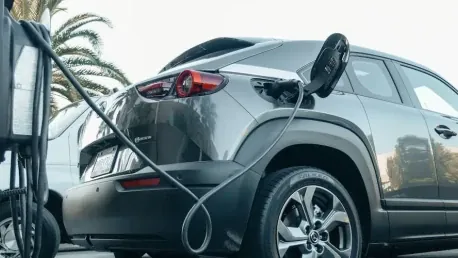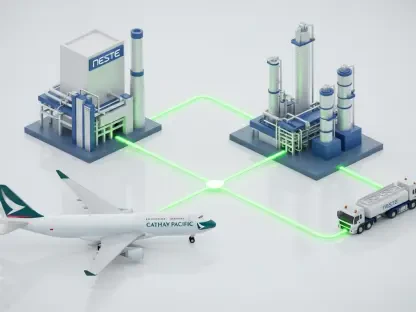Electric vehicles (EVs) have gained significant attention as a sustainable alternative to traditional petrol and diesel cars. As concerns about climate change and environmental degradation intensify, the push for cleaner transportation solutions accelerates. This article delves into the lifecycle environmental impact of EVs, evaluating their production, use, and overall carbon footprint based on recent research findings.
Reduced Emissions in Battery Production
Improved Manufacturing Processes
The production of EV batteries has historically been criticized for its high carbon emissions. However, recent advancements and increased production scales have led to a notable decrease in these emissions. Manufacturers have implemented more sustainable practices and optimized production methods to achieve a 16% reduction in emissions. This progress is significant, especially when considering the growth in EV demand and battery output. These improvements are primarily driven by economies of scale, as the increased demand for EVs leads to more efficient manufacturing processes and better resource management.
Innovations in battery technology, such as the development of higher energy density batteries, also play a crucial role in reducing emissions. These advancements mean that fewer raw materials are needed to produce the same amount of energy, further decreasing the environmental impact of battery production. Moreover, the industry is increasingly moving towards the use of recycled materials in battery manufacturing, which significantly lowers the carbon footprint. As manufacturers continue to refine their processes, it is expected that the emissions associated with EV battery production will continue to decrease, making electric vehicles an even more attractive option for environmentally-conscious consumers.
Life Cycle Assessment Data
Green NCAP’s lifecycle assessment (LCA) data highlights a considerable reduction in emissions during the battery production phase. By analyzing the entire lifecycle of EVs, starting from raw material extraction to vehicle disposal, it becomes evident that the industry is making strides in reducing its environmental impact. Standardized assessments help provide a clearer picture of true environmental costs and benefits. For instance, the LCA data reveals that emissions from battery production have decreased due to greener manufacturing techniques and the use of renewable energy sources in factories.
This comprehensive approach to assessing environmental impact is crucial for understanding the overall sustainability of electric vehicles. It allows manufacturers, policymakers, and consumers to make informed decisions based on a holistic view of an EV’s environmental footprint. As the adoption of electric vehicles continues to rise, these lifecycle assessments will become even more critical in ensuring that the transition to electric mobility is genuinely sustainable. The ongoing improvements in battery production and the increased use of LCAs are promising developments that signal a positive trend towards reducing the environmental impact of EVs.
Cleaner Power Sources
Renewable Energy Adoption
Europe is witnessing a steady increase in renewable energy sources, contributing to cleaner electricity generation for EVs. The International Energy Agency (IEA) notes an impressive 9.6% year-on-year increase in renewable energy production. This shift not only brings down emissions from the power sector but also enhances the green credentials of EVs that rely on this cleaner grid power. As more countries prioritize renewable energy, the carbon footprint of charging an electric vehicle decreases, making EVs a more sustainable transportation option.
The rise in renewable energy adoption is particularly significant in countries with high EV penetration, where the environmental impact of charging plays a crucial role in the overall sustainability of these vehicles. For example, countries like Norway, which boasts a high percentage of renewable energy in its electricity mix, can power their EVs with minimal environmental impact. This trend underscores the importance of aligning renewable energy goals with EV adoption to maximize the benefits of electric mobility. As more regions commit to renewable energy targets, the transition to a cleaner and greener transportation system becomes increasingly feasible.
Emission Projections
As renewable energy continues to expand, projections indicate a 26% reduction in emissions by 2039 in Europe. With more regions committing to renewable energy goals, the electricity that powers EVs is becoming greener, consequently lowering the operational carbon footprint of these vehicles. These projections are based on current commitments and planned investments in solar, wind, and other renewable energy sources, which are expected to play a significant role in decarbonizing the electricity grid.
The future of EVs looks promising as cleaner power sources become more prevalent, further reducing the environmental impact associated with their use. As advancements in energy storage and grid management technologies continue, the integration of renewable energy into the electricity grid will become even more efficient. This will ensure a consistent and reliable supply of clean energy for EVs, solidifying their role as a cornerstone of sustainable transportation. The projected decrease in emissions highlights the critical interplay between renewable energy adoption and the environmental benefits of electric vehicles, making a strong case for continued investment in both sectors.
Emissions from EVs vs. Petrol Cars
Comparative Emissions
The article dispels misconceptions by illustrating that, when accounting for lifecycle emissions, EVs outperform petrol and diesel vehicles in terms of environmental impact. While production emissions for EVs are initially higher due to battery manufacturing, the emissions saved during the vehicle’s operational phase more than compensate for this. Once in use, EVs produce zero tailpipe emissions, significantly reducing pollution levels in urban areas and contributing to better air quality. This contrasts sharply with the continuous emissions produced by internal combustion engine vehicles throughout their operational life.
Studies consistently show that over the lifecycle of a vehicle, EVs result in a lower total carbon footprint compared to their petrol and diesel counterparts. This includes emissions from manufacturing, operation, and disposal. The environmental benefits become even more pronounced when the source of electricity used to charge EVs is considered, with renewable energy sources further enhancing their green credentials. These findings highlight the long-term benefits of transitioning to electric mobility and underscore the importance of considering the full lifecycle emissions when evaluating the environmental impact of different vehicle types.
Break-even Points
Research indicates that depending on the energy mix used for recharging, EVs need to be driven between 47,000 and 146,000 kilometers to break even with the emissions of petrol cars. This range underscores the importance of cleaner electricity grids in maximizing the environmental benefits of EVs. Once past this break-even point, EVs substantially reduce net emissions compared to conventional vehicles. The wide range of break-even points reflects the diversity in energy sources across different regions, emphasizing the need for continued investment in renewable energy.
The break-even distance varies based on several factors, including the efficiency of the EV, the source of electricity for charging, and driving habits. In regions where the electricity grid is dominated by renewable sources, the break-even point is reached sooner, maximizing the environmental benefits of electric vehicles. Conversely, in areas heavily reliant on fossil fuels, the break-even point is higher, though still achievable. These insights highlight the significance of regional energy policies and their impact on the overall sustainability of EVs. As the global energy landscape continues to evolve towards cleaner alternatives, the environmental advantages of electric vehicles are expected to become even more pronounced.
Future Projections and Trends
Decrease in Carbon Footprint
Advancements in battery technology and greater reliance on renewables forecast a continuous drop in the carbon footprint of EVs. A projected decrease of about 20 grams CO2-eq./km for average battery electric vehicles showcases the potential for further reductions in emissions as technology and infrastructure improve. As battery manufacturing processes become more efficient and new materials are developed, the overall environmental impact of producing EV batteries is expected to decline further. This trend is supported by ongoing research and development efforts focused on creating more sustainable battery technologies.
The increasing availability of renewable energy sources also plays a crucial role in reducing the carbon footprint of EVs. As more regions transition to cleaner energy, the emissions associated with charging electric vehicles will continue to decrease, amplifying the environmental benefits of electric mobility. These improvements, combined with advancements in vehicle efficiency and battery longevity, are set to establish EVs as a key component in the fight against climate change. The projected decline in carbon footprint underscores the importance of continued innovation and investment in both renewable energy and electric vehicle technologies to achieve a sustainable transportation future.
Longevity Impact
Over an average lifespan of 16 years and 240,000 kilometers, an EV can potentially reduce its carbon footprint by roughly 15%, which translates to approximately 4.8 tonnes of CO2-eq. savings. This statistic highlights the significant long-term environmental benefits associated with transitioning to electric mobility. The reduced emissions over the vehicle’s lifetime not only contribute to lowering overall carbon emissions but also play a part in mitigating other environmental issues such as air pollution and resource depletion.
The longevity of electric vehicles is further enhanced by advancements in battery technology, which are leading to longer-lasting batteries with higher capacities. These improvements mean that EVs can be used for more extended periods before they need replacement, reducing the frequency of battery production and disposal, and thereby lowering the overall environmental impact. Additionally, the development of effective recycling methods for EV batteries contributes to the sustainability of electric vehicles by minimizing waste and reclaiming valuable materials for reuse. The combined impact of increased vehicle longevity and efficient resource management presents a compelling case for the widespread adoption of EVs as a sustainable transportation solution.
Technological and Production Advancements
Manufacturing Innovations
Enhanced production techniques and greater transparency in lifecycle assessments are driving efficiency in the EV industry. Economies of scale enable manufacturers to lower emissions per unit produced. Moreover, consistent innovation in battery technology contributes to an overall greener production process. For example, the development of solid-state batteries promises higher energy densities and safer operations, which could significantly reduce the environmental impact of battery production. These technological advancements not only improve the performance of electric vehicles but also enhance their sustainability by minimizing the resources required for production.
Another promising innovation is the increased use of recycling in the EV manufacturing process. Recycling not only reduces the need for new raw materials but also diminishes the waste associated with production. This closed-loop system is gradually becoming more prevalent in the industry as manufacturers recognize the economic and environmental benefits of incorporating recycled materials. Furthermore, advancements in digital technologies such as artificial intelligence and the Internet of Things are enabling more efficient manufacturing processes, reducing energy consumption, and optimizing resource utilization. These technological strides are transforming the EV manufacturing landscape, making it more sustainable and environmentally friendly.
Standardization of Data
While manufacturers have become more transparent about their environmental impact, there is an ongoing need for standardized metrics and data comparability. As these systems evolve, they will allow for better-informed consumer choices and more accurate assessments of environmental benefits across different EV models. Standardization efforts are also critical for policymakers and regulatory bodies to consistently evaluate the environmental performance of electric vehicles and implement effective sustainability measures. The establishment of industry-wide benchmarks and guidelines will facilitate more accurate comparisons and drive continuous improvements in the sector.
Standardized metrics will also help in identifying areas that require further attention and investment, such as energy efficiency, manufacturing emissions, and end-of-life recycling. By providing a unified framework for assessing environmental impact, standardization ensures that all players in the industry adhere to the same criteria, fostering a level playing field and encouraging innovation. Moreover, standardization is essential for building consumer trust, as transparent and comparable data allows buyers to make informed decisions based on the true environmental impact of different EV models. As the industry continues to mature, the development and adoption of standardized metrics will play a pivotal role in advancing the sustainability of electric vehicles.
Global Comparisons
Leadership in Renewables
China’s aggressive adoption of renewable energy sources and high EV production rates position it as a global leader in sustainable transportation. Research from the Centre for Research on Energy and Clean Air (CREA) underscores China’s impressive renewable energy generation capacity, suggesting a significant impact on global carbon emissions. The country’s commitment to renewable energy is evident in its massive investments in solar and wind power, which have not only boosted its energy production capacity but also reduced its reliance on fossil fuels. This shift greatly benefits the environmental credentials of the numerous EVs produced and used within its borders.
China’s leadership in renewable energy adoption and EV production showcases the potential benefits of aligning national policies with global sustainability goals. By prioritizing the development of a sustainable energy infrastructure, China is setting an example for other countries looking to reduce their carbon emissions. This approach not only helps to fight climate change but also drives technological innovation and economic growth. As other regions observe China’s progress, there is a growing recognition of the importance of integrating renewable energy with electric mobility to achieve significant environmental benefits. China’s success story underscores the value of comprehensive and coordinated efforts in addressing global sustainability challenges.
International Collaboration
Electric vehicles (EVs) have captured substantial interest as a sustainable alternative to traditional gasoline-powered cars. With the intensification of concerns about climate change and environmental damage, the drive for cleaner transportation options is picking up speed. This article explores the environmental impact of EVs throughout their lifecycle, including their production, usage, and overall carbon footprint, drawing on recent research data.
Production of electric vehicles involves manufacturing batteries, which has a high initial carbon footprint due to the extraction and processing of raw materials like lithium, cobalt, and nickel. However, EVs offset this initial impact over time, as they produce zero emissions during operation compared to their fuel-powered counterparts. This makes them a cleaner option in the long run, especially when charged with renewable energy sources like wind or solar power.
Additionally, the use phase of EVs significantly reduces air pollution, contributing to improved urban air quality. While the disposal and recycling of EV batteries present challenges, continued advancements in technology and recycling methods are expected to mitigate these concerns. Overall, despite the environmental costs associated with their production, EVs offer a more sustainable and environmentally friendly option for the future of transportation when considering their entire lifecycle.









